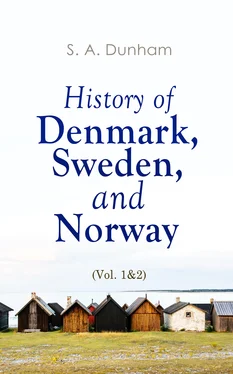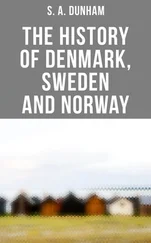|A.C. 70 to A.D. 260.|
The names, succession, and chief exploits of these sacerdotal kings, from Odin to Ingiald Illrada, we have, thanks to the industry of Snorro, been able to lay before the reader. But over those of the royal Goths a cloud hangs which time can never remove. All that can now be done is, from Saxo Grammaticus and the Heimskringla itself, to reserve a few scattered names. Gylfo we have already mentioned; and from the alleged fact—which we have no reason to dispute—that Scania was previously ceded by Odin to his son Heimdal, the seat of Gylfo’s empire must have been in one of the Gothlands. He was followed by Frode and Sigtrug ; the former, remarkable for his liberal presents to the great temple of Sigtuner; the latter, for his misfortunes. Gram, a Danish king (probably the ruler of Scania), having carried off the daughter of Sigtrug, a war followed, which proved fatal to the Gothic king, who was dethroned and slain. That he reigned in Gothland is expressly affirmed by Saxo Grammaticus [141], who relates a graphic incident illustrative of ancient manners. Gram, says the Danish historian, had heard that the princess was affianced to a giant, and he resolved to rescue her from the humiliation; he therefore went into Gothia, and found the royal maiden, with some of her female train, washing at one of the rural streams. Of course she became the prize of the victor, and so did the Gothic kingdom. But Gram did not use his success with moderation; and by Swibdager , a king of Norway, he was slain in his turn. [142]Swibdager was now the lord of three states—of Scania, Gothia, and his hereditary one; but the first he resigned to Guthrum, son of Gram. It was the lot of Swibdager to fall, untimely, by the hands of Hadding, another son of Gram. [142]In his Gothic and Norwegian states he was succeeded by his son Asmund , who, desiring to avenge the death of the father, was also slain by Hadding. Uffo , the son of Asmund , succeeded to the quarrel, though not to the throne, of his two predecessors. That throne was in possession of Hadding; but he was able to raise forces and make a diversion, by landing on the coast of Scania (or, perhaps, Jutland), and forcing the Danish king to return to the defence of his dominions. As it was not Uffo’s design to risk a battle in a foreign state, he sailed for Gothland, and took possession of his hereditary dignity. But with the returning spring Hadding resumed his desire of conquest, and, with a considerable force, landed on the Gothic continent. His followers, however, were soon exhausted by hunger and fatigue; and in the ensuing battle he was signally defeated, and compelled to retreat into Denmark. [143]Unable to accomplish the destruction of his enemy by force, Hadding had recourse to treachery: he sought an interview with Uffo, and removed that prince by assassination; but, according to the Danish account, he placed Hunding , the brother of Uffo, on the vacant throne. The Swedes, however, assert that it was their nation, not the Danes, who thus acted; and their statement is far more credible. Probably there was, as the former assert, a fierce war between the two; and when both found that no advantage was to be expected from it, they eagerly made peace, and were thenceforward more distinguished for their friendship than they had been for their animosity. In the fabulous spirit of the times, it is said that, when one of them heard of the other’s death, he killed himself through grief. We may, however, admit that they died within a short interval of each other. We may add, that this Hadding is not admitted into the list of Danish, that is, of Zealand kings, by the best critics; and that for his actions we are indebted to Saxo. Probably he did not reign at Ledra. [144]
|About 260 to 448.|
Ragnar , the son of Uffo, succeeded to the throne of the Goths, but not until he had rescued it from the domination of his step-mother. His queen was Swanhita, sister of Frode, a king of Denmark; but this alliance did not preserve a good understanding between the two countries. Frode invaded Gothland, but perished in the expedition—not, observes Saxo, by the hands of the enemy, but through a fever, occasioned alike by the heat and the weight of his armour. On the death of Ragnar, the sceptre of the Goths was seized by Holward , or Hodbrod , who was a warlike prince. In his expedition to Denmark, which was then governed by Helge and Roe, he left the latter sovereign dead on the field. But he himself, after his return to Gothland, was mortally wounded by Helge, and his kingdom became the prize of the victor. But Attil I. , the son of Hodbrod, by marrying the daughter of Helge, and, still more, by the bravery of the Goths, was raised to the throne. The issue of this marriage, Hoder , became, in the sequel, king of Scania, no less than of Gothland. This is the Hoder of whom Saxo—so absurd in his chronology—makes the contemporary and rival of Balder, the son of Odin. [145]Ruric, the son of Hoder, was also monarch of both states. He, as we have before related, was the grandfather of Hamlet, through the marriage of his daughter with Horwendil, prince of Jutland. [146]He governed Denmark through his viceroys, and always remained in Gothland; for this reason, he has been often omitted in the list of Danish kings. Of Attil II. we merely know that he was assassinated by a Danish emissary; of Hogmor and Hogrin , who reigned conjointly, that they perished in a battle with the Danes. But Alaric , their successor, appears to have been identical with Elrec , prince of the Swedes, the brother of Eric [147]; and this conjecture is confirmed by the statement of the Swedish historians—that the Goths and Swedes were at this time united. Probably Elrec ruled one nation, Eric another. In the Swedish annals, too, Eric ranks as the brother and successor of Alaric;—a confusion of chronology common enough in the historians of this period. Halfdan (or Halden ) succeeded, who was, probably, the Alf of Snorro. [148]This conjecture, too, is strengthened by the statement of the same Norwegian authority, that Yngve and Alf shared the government of the Swedes. Both would scarcely reign at Upsal; and we have strong reason for inferring that, while Yngve held that throne, Alf, or Halfdan, reigned over the Goths. And there is another confirmation in the fact that, on the death of Alf, the two people obeyed different rulers. In the reigns of Siward , Eric , Halfdan II. , Ragnald , Asmund , and Haquin (or Hako), we observe few points of coincidence between the history of the Goths and the Swedes: probably they were kings of the former people only, with the occasional superiority over Scania. But the name of Hako must not be dismissed without adverting to an incident which the author of Macbeth has admitted into the greatest of his dramas. Hako, resolved to avenge the death of his brothers who had been assassinated at the Danish court, descended with a strong armament on the coast of Zealand, and marched towards the residence of the Danish king. On his way, to avoid observation, he passed through the woods; and when the path diverged into the open plain, he ordered his men each to cut down a large branch, that the paucity of his followers might not be discovered. Great was the wonder of the sentinel, to see a forest approaching the royal fortress, and he immediately carried the information to the king. The latter inquired how far the moving wood was distant from the walls; and, being answered that it was near, he felt that his last hour was also at hand. Issuing from the fortress to meet the foe on the open plain, he met the fate which he had foreseen. [149]
|448 to 623.|
Читать дальше












